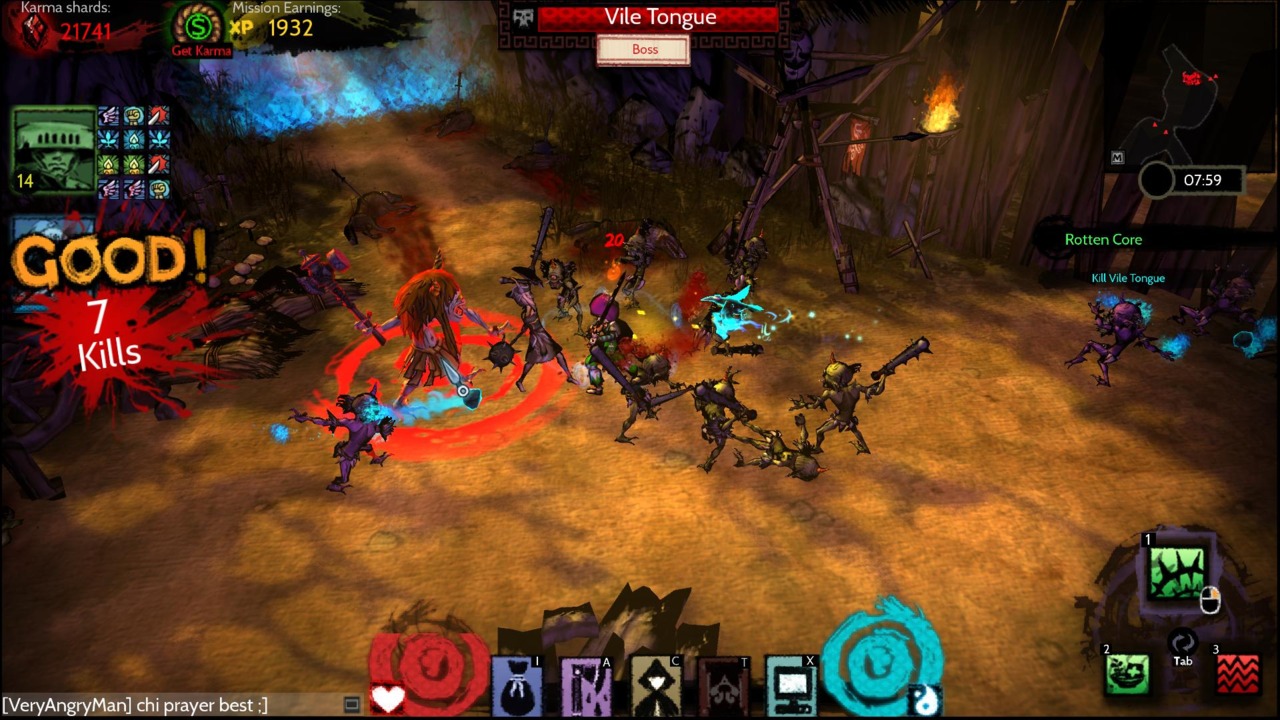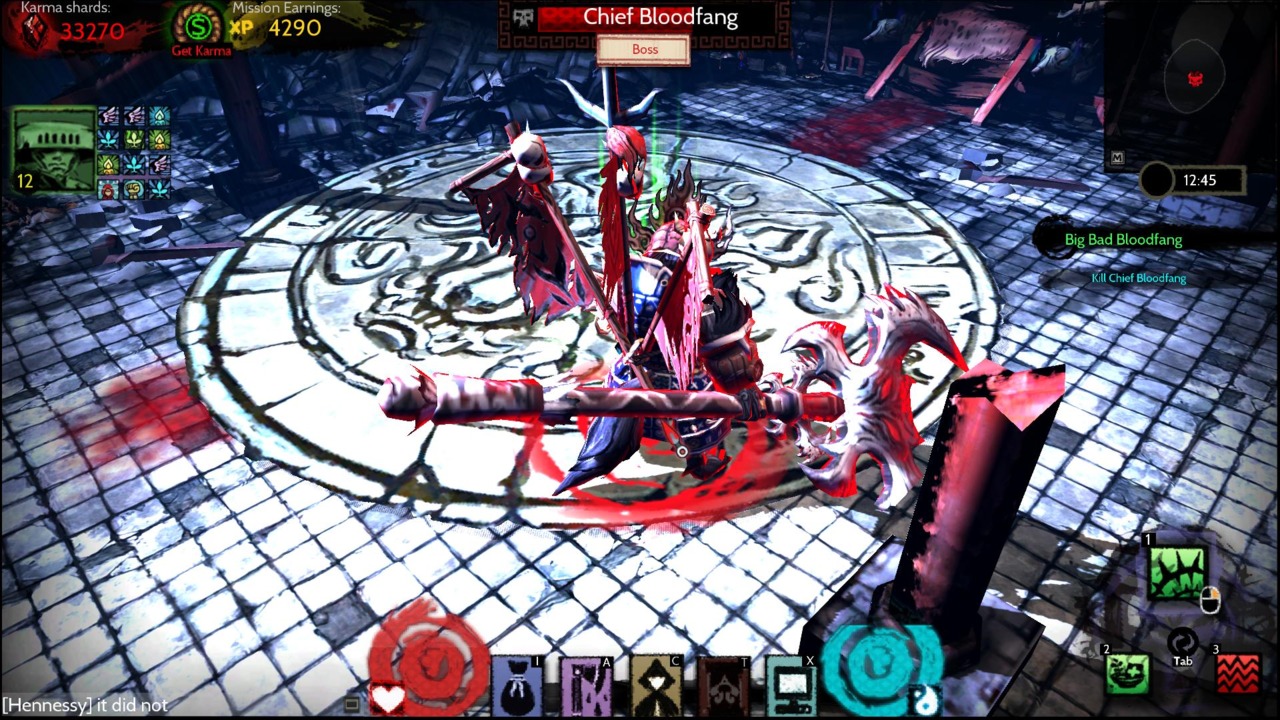What gorgeous tedium Akaneiro: Demon Hunters is. This isometric action role-playing game looks as though it were brushed into existence by a watercolor artist, all colorful swirls and sophisticated flourishes. Sometimes, the gameplay capitalizes on this elegance, matching the fluid visuals with equally velvety action. On the whole, however, Akaneiro is unvaried and monotonous, and its rough edges let down the beauty initially on display. Whether or not you spend money on microtransactions in this free-to-play game, you spend a lot of time repeating content, hoping to earn the right to finally see something new. And there just isn't enough depth or diversity to give this repetition any appeal.
Yet there's no denying that Akaneiro draws you in at first, thanks to its lovely looks and evocative Japanese setting. Some surfaces look like tea-stained parchment, while archways and columns have the asymmetrical beauty of an artist's strokes. You can play the game in a browser window, but to see the game at its best, you should download the stand-alone client. Either way, you must sign in and remain connected to the server to play, even though there is no simultaneous multiplayer for the time being. You can chat with other players, but the lack of co-op is a noteworthy disappointment.
Akaneiro's structure is simple. A small village serves as your hub; there, you purchase skills, weapons, armor, and maybe a spirit animal to join you, which serves as a buff. Then, you select a mission to undertake and begin that leg of your journey. There are no health or mana potions to contend with, though you can consume purchasables like sushi and tofu that give you a temporary stat boost. Instead, you are healed by the karma shards that spill from fallen enemies and treasure chests. It's just you, your wits, and your enemies. The moment-to-moment gameplay has the right kind of feel for such a game; there's enough fluidity to make it a pleasure to click on shambling trees, demonic wolves, and other atrocities, and watch them erupt in colorful fragments. That smoothness will keep you entertained for a few hours as you make your way down Akaneiro's overrun pathways and through its haunted graveyards.

All too soon, however, you discover that to unlock new content, you need to grind. And depending on whether or not you buy karma with real money, that grind could be significant. Not only do karma shards give you health, but they are also the game's currency, and to visit new areas, you need to pay karma to unlock them. Furthermore, you need karma to buy new skills and equipment, among other things. That can mean frequent visits to early levels and revisiting content you've seen many times before--and even if you do pony up the funds to purchase new levels and abilities, you still need to grind for experience. There's no escaping repetition. Granted, each level offers up multiple difficulties, called threat levels, and enemy arrival patterns, miniboss placement, and other details differ between these threat levels. Those tweaks give return visits a modicum of freshness, but not enough to make Akaneiro a varied jaunt. Games like Torchlight II, Path of Exile, and Diablo III offer much more in the way of tactical consideration, level diversity, and pacing shifts.
There may be no co-op, but you can summon an AI mirror of another player to join you. It's nice to have an ally, but this is where some of Akaneiro's problems come to the forefront. Your companion doesn't make good choices, running into the fray all willy-nilly. Furthermore, the AI is incapable of using abilities, and there's no way to tweak AI behavior, so it's common to watch your henchman fall in battle while whaling away on a boss without regard for the brute's attack patterns. You can't bring your companion back during combat stages, either, so once he's down, you're on your own. And bear in mind: you don't earn any experience unless you complete the mission, so losing your companion can be a real setback.

Your companion may also run up to enemies clipped into the environment, or roaming behind impenetrable force fields. This can lead to the AI's untimely death, since you and your companion may not be able to hit your target, even though it can hit you. Such sloppiness is common, with enemies making their way into pieces of the environment they're clearly not meant to reach. Even the loot that flies out of treasure boxes you bash open can fly into unreachable places. Then there are the boss fights, which demonstrate problems with visual tells and collision. You might be so far away from a boss that it's practically offscreen, yet take damage from its attack. On the other hand, you might exploit a boss by hammering on it from behind a column that shields you from its stubborn bites.
The class system gives you some flexibility, allowing you to purchase abilities from three different disciplines. It also allows you to perform ranged attacks, which is fortunate, given that standard combat is conducted only with melee weapons like katanas and claymores. Akaneiro: Demon Hunters is a mostly simple game, and that simplicity doesn't always work to the game's benefit. The action feels good under the fingers, and there's no doubting the visual appeal. But ultimately, Akaneiro offers a limited amount of relatively unvaried content stretched thin by necessary repetition. Developer Spicy Horse promises more content in the future, from cooperative multiplayer to proper tooltips where currently none exist. But for now, this one's for the grinders who need only the promise of better loot to keep pushing forward.